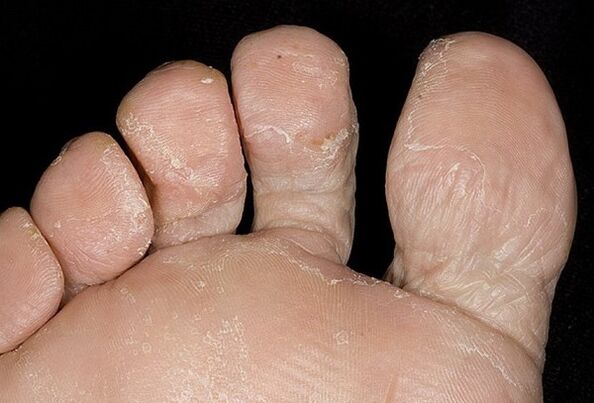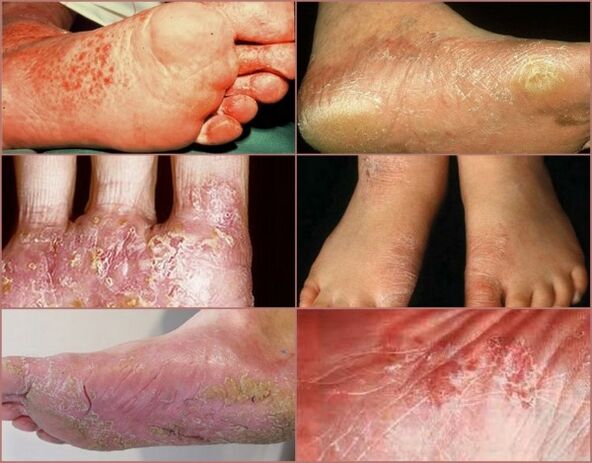Photos and life's skin fungus looks ugly.Not only does it show appearance, unpleasant odors and persistent discomfort, it can cause many problems and can cause serious fungal infections that spread the foot far beyond the foot.
What does the fungus on the legs look like in the photo
The appearance of fungi is diverse - depending on the type of pathogen, skin characteristics, the limitations of the disease, the patient's living conditions, the characteristics of its hygiene status.The main area of lesion positioning is the folding between the nails, fingers and soles.
Affected nails (Onychomycissis) usually have an untidy appearance – yellow, uneven edges, increased fragility, so they collapse.Nails usually become convex, but this can also occur unevenly.
Crossing folds are an area where high humidity is almost constantly retained.They are affected by people who are uncomfortable or do not correspond to weather shoes.As sweat continues to secrete, the fungus reproduction is activated and red spots appear, reminiscent of worn, pale yellow crust with white raided blood wounds.
The lesions of the sole are characterized by peeling, rough and layered skin over the entire surface.At the same time, walking may cause inconvenience and sweating, which may stimulate the growth of fungi even more.
Types of leg fungi

Mycoses in the legs (fungal disease) manifests itself due to the fact that various pathogens are caused.Several types of diseases are distinguished according to the type and characteristics of the fungus in the patient's skin.
rubrophytia is called tr.Mentagrophytesvar- A very contagious fungus that lives in a wet room (public bathroom, swimming pool).One feature is peeling and redness of the skin, swelling of the legs, itching and combs, which are prone to bleeding when damaged.
Candida disease is an infection of candida fungus, the most common pathogenic fungus.Failure across digital folds and soles of the foot is characteristic.There is severe itching, pain, and skin peeling.Under the exfoliating scales, you can see the erosion of the white raid.
Dinoflagellosis is a damage to the nails and may have various severity.Skin lesions are not as deep as Rubrophytius, and are called epidermal plants.Her characteristics are swollen, but noticeable peeling skin.
Development stage
Regardless of the type of pathogen, fungi experience multiple stages in their development:
| Initial phase | The pathology is similar to the legs partially - itching, dryness and peeling of the skin, small cracks appearing, and swelling is possible. |
| Intermediate stage | Active exfoliation of large layers of skin, various shaded spots, severe swelling, itching and impregnation (comb) appearance. |
| Severe stage | Deep cracks that can release blood from it, rich skin exfoliation, the appearance of deep skin defects, and the focus of secondary infections. |
The malfunctioning lesions are performed according to a similar scheme - first, the edges of the nail plate are affected, and then a gray path appears throughout the nail, which thickens, becomes brittle, changes, discolors (yellow, white or black).
Symptoms of Fungal Leg Disease
The most striking symptom of fungal damage to the feet by fungi is severe itching.In the early stages of the disease, it only exists when walking or finding shoes that are uncomfortable "incomplete" shoes.Then it becomes constant and very powerful.Water or pumice procedures can alleviate the condition, but their effects are temporary.
The second bright symptom is skin peeling.It expresses that sometimes reaches a catastrophic proportion when large layers of the skin are peeled off.However, it may not be obvious in nature - the scale of continuous exfoliation captures the increase in the foot.
Change the shape of nails by tumor disease - nails become thick and brittle.When cut into nails, the layer below the nails collapses.In some cases, in difficult situations, you can relax your nails on your nail bed.A new nail grows with hypersensitivity and "path" (irregular shapes).
Initial phase
The skin fungus on the legs (photos that can be seen later) features gradual development.Therefore, in the early stages, the disease may not show in any way.The initial signs are very nonspecific - long walking, rough skin, appearance of peeling scales on the soles.Nail fungi do not show longer than skin fungi.
Some signs you can suspect of fungi:
- Swimming pool, sauna, gym or any other place with high humidity and large numbers of tourists, skin condition worsens;
- Itching in a damp environment;
- The pigmentation of the skin changes - spots appear;
- Peeling occurs unevenly along the entire foot, focusing more on the area between the fingers and the sole.
- Similar symptoms were observed at the same time among several people who visited a possible infection in a group or lived in the same apartment.
Interdalz form
This form is the most unpleasant for patients.The main positioning of the lesions is the folds between the fingers, most of the fingers suffer less - folding between 1 and 2.This is related to the characteristics of the sole structure.For fungi, high temperature and humidity conditions are optimal, while minimum exposure to air may eliminate mechanical factors that can be used to eliminate fungi.
It is the condition created between 3 and 3 fingers - all fingers are the least moving.
Characteristic Symptoms - Itching and burning in the location of the lesion, similar to the appearance of the lesion's skin that rubs, and as the disease progresses, they become inflammatory ulcers covered with a white coating.Contact them is very painful, and the symptoms of the disease increase in hot weather, uncomfortable shoes and increased humidity.
How does the scaly hyperkeratotic phase manifest
This stage is a characteristic of the disease that affects the soles.Its most vivid symptoms express skin peeling, which has excessive keratinization.The sole looks rude, the skin is less sensitive and it becomes unpleasant to touch it.The scales are removed by large layers and vice versa, and their separation is difficult to occur, and the skin is possible.
Easier on feet affected by fungi, corn, corn and other pathological phenomena.Walking becomes uncomfortable - During long stays, itching and pain in the legs are exacerbated.

dyshidrotation stage
It is characterized by changes in sweating.No fungi can settle in the sweat glands, but indirectly affects the epidermis, and the inflammatory process can destroy sweat.
The particularity of this form is the formation of large blisters on the skin, which can easily merge with each other.In most cases, the disease begins in the form of a return ball and obtains a serious progression process.
The second feature is sweat on the legs and unpleasant legs odor.On the soles, there are roots (distinguishing thick sweat) sweat glands, which explains the scent that is more distinct than in healthy people.Due to fungi, sweating increases, so the odor increases.
Diagnosing leg fungi
The skin fungus on the legs (photos given below) has a characteristic external manifestation, so the dermatologist begins the diagnostic process by examining the affected limb.The surgery should be performed specifically with gloves, because for the doctor, there is a great risk of infection from the patient.
Information received during the examination illuminates the history of anatomy - visiting fungi, wearing someone else's shoes or living with the patient in the same apartment where they can live.
For a more accurate diagnosis, microbial examinations were performed - a small fraction of the debris separated from the air bubbles were collected in a sterile container and then examined under a microscope.Therefore, such analysis requires time to confirm or adjust the treatment regimen, or in the event of a problem arising from the fungus.
Effective treatment methods
The main task of treatment is to eliminate pathogens.To this end, a variety of products are used that are suitable for affected skin or internal ingestion.All family members must rule out reinfection treatment.
For the same purpose, when visiting public places, you need to get used to following personal hygiene rules and prudent rules, where you can get infected with fungi.
In treatment, fungi should not use antibiotics under any circumstances—these drugs can cause bacteria to die and release the living space of the fungus, which aggravates the patient’s condition.However, since fungi are part of the normal skin flora, products that increase immunity will produce good results.
Good and cheap ointment
Skin fungi on the legs are treated comprehensively.The most important thing is to eliminate pathogens.
To do this, use antifungal creams - apply them directly to the skin and affect the affected areas of the feet.Additionally, they do not cause systemic side effects, i.e. do not absorb blood.
After washing your legs, apply the ointment to the skin, at a daily application of 3-8, depending on the strength of the process and the type of ointment.The tool does not require washing, but it should be allowed to absorb before putting on the socks and shoes (5-10 minutes).
To fight the fungus of the nails, there are drug varnishes.They are colorless and have no odor.The varnish covers the nails with a layer of medicine that has been stored for one day, without being washed with water, without washing, and does not require daytime renewal.This can make working hours tight or vacationing people.
To enhance the effect of antifungal ointments, it is recommended to treat the skin with topical preservatives (Miramistin, Boron's alcohol solution and salicylic acid, hydrogen peroxide, chlorhexidine).
Preparation for internal use
Oral administration is performed using drugs when the disease has achieved a severe course, wide distribution or if the patient is unable to treat the legs with antifungal drugs at sufficient frequency.Additionally, prescriptions can be prescribed to boost immunity.
The skin fungi on the legs are further presented in the picture and treated with antifungal drugs.They are used in combination with ointments or standalone tools.In this case, the doctor decides which tool to show.
As fungal complications develop, intravenous injection and introduction of the same medication may be required.
In complex therapies, anti-inflammatory drugs, immunity-enhancing drugs, and other drugs can be prescribed.The purpose of this purpose is to increase the body's resistance to pathogenic effects and to improve the effectiveness of antifungal treatment.
Folk remedies against fungi
Civil remedies to fight fungi are also based on anti-inflammatory and disinfectant effects.In most cases, these are foot baths based on various medicinal costs.They are less effective than pharmacies, but can improve the health of patients.Before using them, it is recommended to consult a doctor to avoid reducing the overall efficiency of treatment.

The skin fungus on the legs (the photo below shows the problem looks unattractive, even if it is not treated) was successfully eliminated by the bathroom with Celandine or Choollula.To this end, the raw materials of the plant are adhered to boiling water, and the resulting mixture is filtered and dissolved in warm water.The temperature of the bathroom should allow the patient to comfortably place his legs in it.
As other components, you can add chamomile, cow, plantain and worms.
It is also recommended to use washing powder (any) as the primary therapeutic ingredient in the bathroom, lubricate the affected area with BF glue and iodine or vinegar.It should be remembered that folk recipes need to be circulated with caution to make health-free.
prevention
To avoid fungal infections, several simple rules should be observed:
- Observe personal hygiene rules - the legs should be clean and dry, and for dry skin you need to use cream;
- Wear comfortable socks and shoes, corresponding to the weather, choose "breathing" materials to create comfortable conditions for the skin;
- Use slippers as a pool when visiting the pool, public bathrooms and other places where fungi can be infected, and then wash your legs when you get home;
- Use only sanitary accessories - towels, pedicure scissors;
- If a fungus is detected, treatment is required for the entire family, regardless of whether the symptoms appear.
A good result can strengthen the hardening and other procedures that strengthen the immune system.This avoids the development of fungal infection during the infection process.Monitoring nutrition is important - receiving enough protein and vitamins to support immunity, and excessive candies can stimulate fungal growth.
Photos of skin fungi on the legs look offensive, but the disease can be cured in the right way.It can be cured quickly (within 1-2 weeks).If no complications develop, the patient can undergo the treatment process without interrupting work and rest.The most severe and most advanced cases of patients with immune disorders only require hospitalization.
















